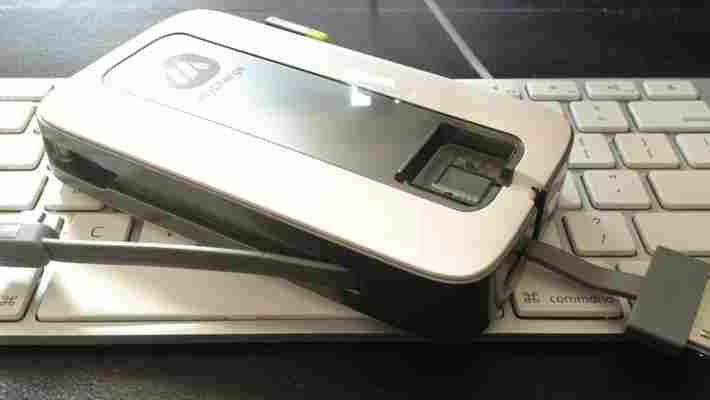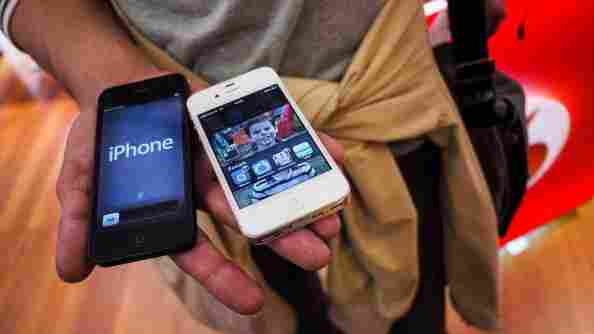Let’s talk batteries. Their short lives are pretty much the bane of happiness for we electronics junkies. While there are a number of solutions out there for extending and recharging them, none has managed to impress me quite as much as the myCharge Peak 6000 .

If you visit the myCharge site, the first thing that you’ll notice is a lot of external batteries that look quite similar to other offerings from companies like Mophie . While I’m a huge fan of Mophie’s products, having a clone of them didn’t float my boat. But if you scroll around a bit you’ll find myCharge’s new models, Peak and Summit.
The major difference, and one big selling point for me, is that there’s a flip-down wall plug on the unit. So instead of having to carry around a wall adapter and a USB cable, you just plug the Peak right into an outlet. But the differences go deeper as well, so let’s talk about them.
The Peak is a 6000 mAh battery, meaning that your average cell phone can be charged to full about 4 times. There’s an Apple 30-pin connector for charging your iPhone or iPad directly, and an extra USB port for powering the device of your choice.
Yes, I said iPad. That’s the next, major difference. Chances are that you’re familiar with how iPad charging works. It requires a higher amperage than the iPhone, so most chargers for the iPhone won’t add any battery life to the iPad. Not the case with the myCharge. The team has included a smart-switching circuit that provides the necessary juice to bring your iPad battery back to life.
Now it’s not going to charge an iPad battery back to full, as the 11,000+ mAh juice pack for the tablet simply has more capacity than the myCharge Peak 6000 can fill. But it will get you back over half full and, for a tablet that has the extraordinary battery life of the iPad, that means you’ll be able to get through a long day with ease.
Along the side of the Peak you’ll also find a full-sized USB port for charging the device via your laptop or wall charger. While that’s great, that’s exactly the problem that I’ve had with most of the external batteries that I’ve used up until now. I’m finding myself, increasingly, traveling with only my iPad. I don’t want to carry extra plugs and cables. Plugging in the Peak to the wall, I can charge my iPhone and iPad while the unit itself charges too.
The other “oh hey, that’s cool” feature of the Peak is that the full-sized USB works as a data passthrough so that if you do have it plugged in to your computer, you can then charge and sync your iPhone or iPad via the included 30-pin connection. Along the opposite side there’s another attached cable with a micro-USB plug for whatever other charging need you might have.
Battery life monitoring is a different animal with the Peak. There’s a white button along the bottom that, when pressed, triggers a voice recording that tells you the approximate battery level that remains. When full, for instance, the device says “Battery is full”. If you’re down around half, it will tell you “battery has fifty percent remaining.”
At a price of $100 (you can find it cheaper) it’s certainly not the cheapest battery on the market, but it’s positively the handiest one I’ve used yet. It answers a common pain point for those of us who travel sans laptops, but doesn’t ignore those of us who are still tied to them.
➤ myCharge Peak 6000
Jailbreaking your phone is legal in the US, but not for other mobile devices
The United States government has ruled that it’s perfectly legal for you to jailbreak your phone — and by jailbreak, we mean that it’s not going to violate any copyright laws. But don’t think that you’re going to be able to legally hack any of your other devices, because the US Copyright Office says that tablets are excluded from this ruling.

As reported by The Verge , the US Copyright Office issued rulings on exemptions to the Digital Millennium Copyright Act (DMCA) today and said that the “category of tablets is difficult to define” so rather than issue a blanket exemption, it declined to lump tablet devices in with phones.
The DMCA was created by the US government in an attempt to implement and adhere to the WIPO Copyright Treaty and WIPO Performances and Phonograms Treaty that were both passed in 1996. The Act was designed to establish rules in the digital marketplace to govern copyright owners, consumers, manufacturers, distributors, libraries, educators, and online service providers.
What the US Copyright Office was judging specifically was software interoperability. The issue before the Office was how to address:
The item on the docket seems to address iPhone and smartphone usage because when you’re dealing with applications, the one issue that many face is that you can find it on one platform, but not always on the other.
The Electronic Frontier Foundation, along with the New America Foundation’s Open Technology Initiative, New Media Rights, Mozilla Corporation, and the Free Software Foundation petitioned the US Copyright Office to grant an exemption to the DMCA and it was ruled that since many smartphones have access control protections, the request to have “lawfully acquired applications interoperable with the handset’s software” was deemed fair and that access controls “adversely affected that function.”
But when the issue surrounding tablets came up, the US Copyright Office determined that there was insufficient basis to grant an exemption, but it did leave the door open for future exemptions. Opponents of granting an exemption claimed that the DMCA already defined “the contours of acceptable circumvention related to interoperability” and in the end, managed to sway the ruling in their favor, but there was one important note to the ruling. The US Copyright Office found that:
So the exemption appears to be granted to smartphones because they had been widely adopted, more so than tablets. As more applications become available for these devices and as it proliferates through our daily lives, you could probably expect the government to review its exemption ruling again and allow interoperability to become legal.
This ruling came at the US Copyright Office’s triennial meeting.
Image credit: ANDREAS SOLARO/AFP/Getty Images
Memoto: This tiny, wearable camera wants to capture your day in photos, taking lifelogging mainstream
Lifelogging – the idea of carrying a tiny camera around with you and recording images from your entire day automatically – is nothing new , and yet it’s failed to catch on as yet. A new device and online service from Swedish startup Memoto that has just launched a campaign on Kickstarter, could change that.

Measuring just 1.4 x 1.4 inches, the Memoto clips on to your clothing. It takes a picture every thirty seconds throughout the day via its 5 megapixel camera, timestamping and geotagging each shot. Once you connect to your computer via USB, it will begin uploading your images to the accompanying Web service.
Now, there are 1,440 minutes in 24 hours, so that means Memoto is going to be taking up to 2,880 photos per day. Most of them are going to be worthless and repetitive shots. To counter this, the Memoto service automatically identifies different parts of the day and divides them into ‘moments’ so you can easily find the interesting parts of the day.
Most people won’t use Memoto all day every day, although with a promised 2-day battery life, it can certainly be a tool for hardcore lifeloggers. It should work just as well for capturing a fun day out or a vacation though.
Memoto is the new project from Martin Källström, the former CEO of blog search and media monitoring company Twingly ( The Next Web Award contenders way back at our 2008 conference). The Kickstarter campaign begins today, and the startup says that it’s weeks away from having final working hardware in the final form factor. Launch is planned for early 2013.
The unit will be available in grey, white and orange colors for $279. However, if you back the Kickstarter campaign to the tune of $199 or more, you’ll receive a camera and 1-year Web service subscription when Memoto becomes available.
Now, some people will no doubt argue that lifelogging isn’t of mainstream interest, but Memoto and Google’s Project Glass look set to commoditize it like never before. With the likes of Fitbit and the Nike+ FuelBand , the idea of wearable computing is entering the mainstream. Memoto might have timed its arrival on the market just right.
UPDATE: The Kickstarter campaign has reached its $50,000 goal already, in around 5 hours, although there are still plenty of the initial batch of 1,000 devices available. It’s important to note that it is our understanding that the company has some degree of angel/seed funding from elsewhere too, although we’re currently clarifying the details of this.
UPDATE 2: Memoto tells us that the Kickstarter campaign is definitely no mere publicity campaign. The startup has raised €500,000 ($651,000) from early stage venture fund Passion Capital and angels Peter Read and Felix Petersen, but this does not cover production costs – so if you want to help this interesting device get off the ground, they’d still appreciate your backing over the remaining 37 days of the campaign.
➤ Memoto
